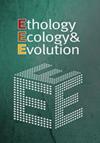日本石蟹(Petrolisthes japonicus)自切肢后肢体运动
IF 1.1
4区 生物学
Q4 BEHAVIORAL SCIENCES
引用次数: 4
摘要
在一些脊椎动物和无脊椎动物分类群中,自切后的附属物运动是独立进化的。移动的附属物可能会转移捕食者对身体的注意力,让猎物逃脱。十足甲壳类动物,特别是异蟹类和短蟹类,在自切方面得到了很好的研究;然而,没有研究关注自切肢体后的行为。我们首先用日本石蟹(Petrolisthes japonicus)发现了十足甲壳类动物自切肢后的肢体运动。蟹类有很大的蹄足。当掠食者螃蟹抓住它的螯时,瓷蟹很容易自动控制螯,使它能够逃脱。我们的实验室观察表明,日本鳗鲡的自动螯足具有自主运动的特点:它们重复地闭合和伸展螯足和腕骨关节上的剩余部分。鳍足动物的划水次数(单个连续的闭合和伸展运动)和总划水时间平均分别约为28次和17秒。自体切开术后的足跖运动可能进一步提高具有毛触发性自体切开术反应的大型足跖动物的反捕食者防御效能。本文章由计算机程序翻译,如有差异,请以英文原文为准。
Post-autotomy limb movement in the porcellanid crab Petrolisthes japonicus
Post-autotomy appendage movement has evolved independently in several vertebrate and invertebrate taxa. Moving appendage may divert a predator’s attention away from the body, allowing the prey to escape. Decapod crustaceans, particularly anomuran and brachyuran crabs, have been well studied in terms of autotomy; however, no studies have focused on post-autotomy limb behaviour. We first found post-autotomy limb movement in decapod crustaceans using the porcellanid crab Petrolisthes japonicus. Porcellanid crabs possess large chelipeds. The porcellanid crab autotomizes the cheliped readily when a predator crab grasps it by the cheliped, enabling it to escape. Our laboratory observations revealed that autotomized chelipeds of P. japonicus moved voluntarily: they repeated closing and stretching movements of the chela and remaining parts on the propodus-carpus joint. The number of strokes (a single sequential closing and stretching movement) and the total stroke duration of the chelipeds were about 28 times and 17 sec on average, respectively. Post-autotomy cheliped movement may further improve the anti-predator defence efficacy of large chelipeds with a hair-trigger autotomy response in porcellanid crabs.
求助全文
通过发布文献求助,成功后即可免费获取论文全文。
去求助
来源期刊

Ethology Ecology & Evolution
生物-动物学
CiteScore
3.10
自引率
0.00%
发文量
44
审稿时长
>12 weeks
期刊介绍:
Ethology Ecology & Evolution is an international peer reviewed journal which publishes original research and review articles on all aspects of animal behaviour, ecology and evolution. Articles should emphasise the significance of the research for understanding the function, ecology, evolution or genetics of behaviour. Contributions are also sought on aspects of ethology, ecology, evolution and genetics relevant to conservation.
Research articles may be in the form of full length papers or short research reports. The Editor encourages the submission of short papers containing critical discussion of current issues in all the above areas. Monograph-length manuscripts on topics of major interest, as well as descriptions of new methods are welcome. A Forum, Letters to Editor and Book Reviews are also included. Special Issues are also occasionally published.
 求助内容:
求助内容: 应助结果提醒方式:
应助结果提醒方式:


